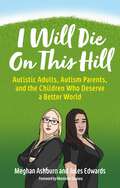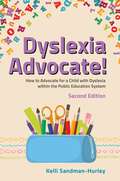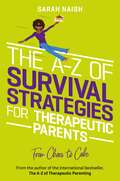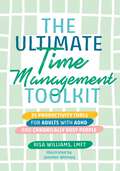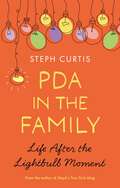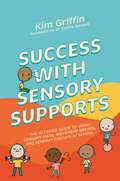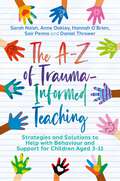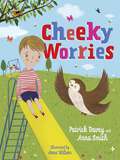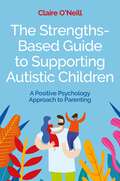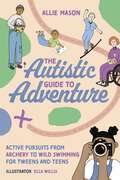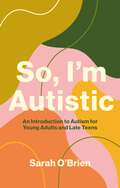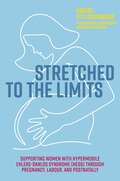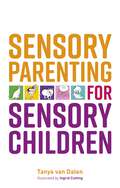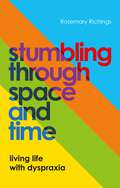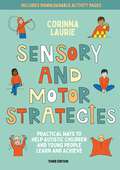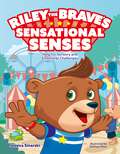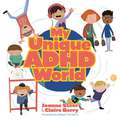- Table View
- List View
I Will Die On This Hill: Autistic Adults, Autism Parents, and the Children Who Deserve a Better World
by Meghan Ashburn Jules EdwardsThere is a significant divide between autistic advocates and parents of autistic children. Parents may feel attacked for their lack of understanding, and autistic adults who offer insight and guidance are also met with hostility and rejection. Meghan Ashburn, a mother of two autistic boys, and Jules Edwards, an autistic parent, were no strangers to this tension and had an adversarial relationship when they first met. Over time, the two resolved their differences and are now co-conspirators in the pursuit of disability justice. This book unites both perspectives, exploring the rift between these communities and encouraging them to work towards a common goal. It provides context to dividing issues, and the authors use their experience to illustrate where they've messed up, where they've got things right, and what they've learned along the way.
Dyslexia Advocate! Second Edition: How to Advocate for a Child with Dyslexia within the Public Education System
by Kelli Sandman-HurleyThis updated edition of this bestselling, straightforward guide provides the essential information for parents and advocates to understand US law and get the right educational entitlements for a dyslexic child.Using case studies and examples, this book demonstrates clearly how to apply the Individuals with Disabilities Education Act (IDEA) to the unique requirements of a dyslexic child. It offers simple, intelligible help for parents on how to coordinate successfully with their child's school and achieve the right services and support for their dyslexic child; up to and beyond getting an effective Individual Education Plan (IEP).Dyslexia Advocate! is an invaluable tool for parents trying to negotiate a complex legal system to get the best outcome for their child. With brand new chapters on the structure of special education services in the US and current state laws, this guide is fundamental to understanding and advocating for your dyslexic child.
The A-Z of Survival Strategies for Therapeutic Parents: From Chaos to Cake (Therapeutic Parenting Books)
by Sarah Naish'This book is your hot flask of tea or coffee, and a cosy blanket which will keep you warm, safe and well on your journey, ensuring you reach the other side, mentally and physically well.'So, you want to help your child by therapeutic parenting, but how are YOU?This easy-to-follow, dip-in dip-out resource addresses common challenges and feelings experienced by therapeutic parents and offers 80 practical strategies to help you cope and survive. Bestselling parenting author Sarah Naish writes with humour and compassion, sharing her personal and professional experiences covering all of the essentials: self-maintenance, coping with isolation and rejection, scheduling holidays and, of course, the therapeutic importance of cake!Think you don't have the time or inclination for a bit of 'self-care'? This book will save time, save energy and help solve your problems - a 'must have' for all therapeutic parents.
The Ultimate Time Management Toolkit: 25 Productivity Tools for Adults with ADHD and Chronically Busy People (Ultimate Toolkits for Psychological Wellbeing)
by Risa WilliamsDo you find time constantly slipping away from you? Or does completing a to-do list feel totally unachievable? We all have 24 hours in a day, but sometimes putting them to good use can feel like an impossible task. The Ultimate Time Management Toolkit is here to change that!Written by a clinical therapist and author of The Ultimate Anxiety Toolkit, this book focuses on practical methods and strategies, including creative worksheets and easy to use techniques, to help you find your motivation, achieve your goals and feel less stressed about organizing your time.With 25 different techniques based on CBT, mindfulness and narrative therapy, you can find out which strategies work best for you to help transform how you use your time and learn how to feel empowered to make positive changes to habits in your daily life.
PDA in the Family: Life After the Lightbulb Moment
by Steph CurtisIn this honest and open account of life with her PDA daughter, Sasha, Steph Curtis reveals the everyday struggles and explores the milestones of raising a child diagnosed with Pathological Demand Avoidance. This book guides you through the Curtis family's 'lightbulb moment' of recognising Sasha's PDA profile following her autism diagnosis at the age of two, their experiences of various education settings and attempts to access support, everyday life at home and relationships with family and friends. Bursting with practical takeaways and advice from creating personal profiles for your child to help them transition through schools and other settings to the reasonable adjustments you can actually ask for to help make life easier for your PDA child.With unique insights from Sasha's father, sister, and Sasha herself, this book offers insider knowledge, understanding and advice from one family to another. It would also be helpful for those in education, healthcare or other settings to gain a better understanding of Pathological Demand Avoidance.
PDA in the Family: Life After the Lightbulb Moment
by Steph CurtisIn this honest and open account of life with her PDA daughter, Sasha, Steph Curtis reveals the everyday struggles and explores the milestones of raising a child diagnosed with Pathological Demand Avoidance. This book guides you through the Curtis family's 'lightbulb moment' of recognising Sasha's PDA profile following her autism diagnosis at the age of two, their experiences of various education settings and attempts to access support, everyday life at home and relationships with family and friends. Bursting with practical takeaways and advice from creating personal profiles for your child to help them transition through schools and other settings to the reasonable adjustments you can actually ask for to help make life easier for your PDA child.With unique insights from Sasha's father, sister, and Sasha herself, this book offers insider knowledge, understanding and advice from one family to another. It would also be helpful for those in education, healthcare or other settings to gain a better understanding of Pathological Demand Avoidance.
Success with Sensory Supports: The ultimate guide to using sensory diets, movement breaks, and sensory circuits at school
by Kim GriffinSensory needs are being recognised as a vital part of learning, development and engagement within the classroom and are being used more often to make education both accessible and fun. To harness the full potential of sensory supports, using these strategies correctly is key!This is the essential guide to using sensory strategies successfully with school children, from occupational therapist, Kim Griffin, who has 20 years of experience supporting sensory needs.As you make your way through the book, you will be joined by Isla and Noah, two children whose stories will help illustrate how information in the book can be used practically. In addition, the book includes personal anecdotes from Kim, links to further reading, reflective questions and teacher perspectives to show how a teacher might use the information in the classroom. These features will help you easily identify sensory needs and use sensory tools effectively.
Success with Sensory Supports: The ultimate guide to using sensory diets, movement breaks, and sensory circuits at school
by Kim GriffinSensory needs are being recognised as a vital part of learning, development and engagement within the classroom and are being used more often to make education both accessible and fun. To harness the full potential of sensory supports, using these strategies correctly is key!This is the essential guide to using sensory strategies successfully with school children, from occupational therapist, Kim Griffin, who has 20 years of experience supporting sensory needs.As you make your way through the book, you will be joined by Isla and Noah, two children whose stories will help illustrate how information in the book can be used practically. In addition, the book includes personal anecdotes from Kim, links to further reading, reflective questions and teacher perspectives to show how a teacher might use the information in the classroom. These features will help you easily identify sensory needs and use sensory tools effectively.
The A-Z of Trauma-Informed Teaching: Strategies and Solutions to Help with Behaviour and Support for Children Aged 3-11
by Sarah Naish Anne Oakley Hannah O'Brien Sair Penna Daniel Thrower"This is a remarkable achievement. Like Batman's Utility belt for teachers. So many practical, wise, inspiring, and achievable ideas are packed in here. I can imagine this becoming as indispensable for teachers as Gray's Anatomy is for doctors..." - Stephen Fry"If you want a book to assist with your work with traumatised children, choose this one. It is the best!" - Professor Peter Fonagy OBE, Chief Executive, Anna Freud National Centre for Children & Families"Humane and grounded in science, this book could change lives." - Sir Norman Lamb, Chair of Maudsley NHS and Children and Young People's Mental Health CoalitionWhat does trauma-informed teaching really look like in the classroom, and can we really achieve it?Maybe you, like many other teachers, will reach the end of a busy day feeling exhausted, deskilled and less than keen to dive into a book on the theory of trauma. Luckily you won't find any complex theory or jargon in this book, but you will gain an understanding of how small humans develop, how perplexing behaviours can be explained and learn inclusive strategies that will help all children in your classroom and school. Part 1 provides you with an explanation of what trauma-informed teaching involves. Then, Part 2 lists an A-Z of issues and behaviours for you to flip to in your busiest moments, ranging from Aggression and Lateness right through to Learning Challenges and Zzz (sleep issues). Gain new understanding into the children in your classroom with this book offering you strategies to better support every child's mental health and resilience.
Cheeky Worries: A Story to Help Children Talk About and Manage Scary Thoughts and Everyday Worries
by Patrick Davey Anna SmithFinn LOVES adventures and having fun!But when he starts to have 'cheeky worries', a Wise Owl knows just what to do...Cheeky worries are those sneaky thoughts that pop up when you're least expecting it. You might be getting ready for bed, playing with friends at the park or having fun on the bus when suddenly a scary thought pops into your head. Through the character of Finn and a wise owl, this book equips children and adults with a common language to discuss their emotional worlds and worries. It gently introduces psychological principles and evidence-based techniques that help children ages 4-8 develop resilience and deal with anxiety.
The Strengths-Based Guide to Supporting Autistic Children: A Positive Psychology Approach to Parenting
by Claire O'Neill'Being strength-aware has brought many moments of joy to our family life. It is this potential for growth and joy that I now want to share in this book'This flexible, dip-in-dip-out guide will introduce you to the strengths-based approach that is helping autistic children and their families to thrive. By focusing on how to identify, develop and use your child's strengths to support them throughout childhood and into adolescence, this transformative approach is here to show you and your child that their unique character-strengths can empower them and shape their future.Claire O'Neill combines her personal experience as an autistic person and mother to autistic children with her expert knowledge as a professional working with autistic young people to demonstrate the value of a strengths-based approach.With step-by-step instructions on how parents and teachers can incorporate this approach easily into family and school life, Claire also offers a variety of specific tips, tricks and engaging activities to provide ongoing support for parents and teachers alike.
The Strengths-Based Guide to Supporting Autistic Children: A Positive Psychology Approach to Parenting
by Claire O'Neill'Being strength-aware has brought many moments of joy to our family life. It is this potential for growth and joy that I now want to share in this book'This flexible, dip-in-dip-out guide will introduce you to the strengths-based approach that is helping autistic children and their families to thrive. By focusing on how to identify, develop and use your child's strengths to support them throughout childhood and into adolescence, this transformative approach is here to show you and your child that their unique character-strengths can empower them and shape their future.Claire O'Neill combines her personal experience as an autistic person and mother to autistic children with her expert knowledge as a professional working with autistic young people to demonstrate the value of a strengths-based approach.With step-by-step instructions on how parents and teachers can incorporate this approach easily into family and school life, Claire also offers a variety of specific tips, tricks and engaging activities to provide ongoing support for parents and teachers alike.
The Autistic Guide to Adventure: Active Pursuits from Archery to Wild Swimming for Tweens and Teens
by Allie MasonIt's time for a new generation of autistic adventurers!Outdoor adventuring can be life changing - it makes you physically and mentally stronger, takes you to new places and introduces you to new friends, as well as being an exhilarating challenge - but it can be stressful when there are unexpected social and sensory challenges involved. Allie Mason, autistic adventurer extraordinaire, is here to help. Join Allie as she introduces activities ranging from archery to stargazing, sailing to fossil hunting, snorkeling to nature-writing - and so much more. Each easily digestible factsheet comes with a short introduction, a summary of the sensory experiences involved, suggestions on approaching activities for when you're just getting started, as well as a handy budgeting system. With personal anecdotes and interviews with awesome autistic athletes, this book will give you the support you need to take on the great outdoors.
The Autistic Guide to Adventure: Active Pursuits from Archery to Wild Swimming for Tweens and Teens
by Allie MasonIt's time for a new generation of autistic adventurers!Outdoor adventuring can be life changing - it makes you physically and mentally stronger, takes you to new places and introduces you to new friends, as well as being an exhilarating challenge - but it can be stressful when there are unexpected social and sensory challenges involved. Allie Mason, autistic adventurer extraordinaire, is here to help. Join Allie as she introduces activities ranging from archery to stargazing, sailing to fossil hunting, snorkeling to nature-writing - and so much more. Each easily digestible factsheet comes with a short introduction, a summary of the sensory experiences involved, suggestions on approaching activities for when you're just getting started, as well as a handy budgeting system. With personal anecdotes and interviews with awesome autistic athletes, this book will give you the support you need to take on the great outdoors.
So, I'm Autistic: An Introduction to Autism for Young Adults and Late Teens
by Sarah O'Brien'There isn't a secret manual outlining exactly how to get through your teens and young adulthood as an autistic individual, but this book provides a script for how to do what adulthood will make you do anyway, in a way that is most accessible for you".You've just received an autism diagnosis, so why do you still feel so lost when it comes to what autism actually means for you?Written by autistic advocate Sarah O'Brien, this book gives a much-needed introduction into what autism is and removes the myths, stereotypes and stigma that surround it. Sarah provides insights into what to do after diagnosis and how to approach and navigate the process of informing those in your life, from your family and friends to your teachers or manager at work. Utilising her own experience of feeling lost after diagnosis and navigating all of the 'firsts' of adolescence and young adulthood Sarah provides an honest and friendly voice to guide you through it all.Intelligent and clearly-written, this is the fact-led and information-rich resource that will answer your questions about autism, introduce you to your new community and set you up to thrive as an autistic adult.
So, I'm Autistic: An Introduction to Autism for Young Adults and Late Teens
by Sarah O'Brien'There isn't a secret manual outlining exactly how to get through your teens and young adulthood as an autistic individual, but this book provides a script for how to do what adulthood will make you do anyway, in a way that is most accessible for you".You've just received an autism diagnosis, so why do you still feel so lost when it comes to what autism actually means for you?Written by autistic advocate Sarah O'Brien, this book gives a much-needed introduction into what autism is and removes the myths, stereotypes and stigma that surround it. Sarah provides insights into what to do after diagnosis and how to approach and navigate the process of informing those in your life, from your family and friends to your teachers or manager at work. Utilising her own experience of feeling lost after diagnosis and navigating all of the 'firsts' of adolescence and young adulthood Sarah provides an honest and friendly voice to guide you through it all.Intelligent and clearly-written, this is the fact-led and information-rich resource that will answer your questions about autism, introduce you to your new community and set you up to thrive as an autistic adult.
Stretched to the Limits: Supporting Women with Hypermobile Ehlers-Danlos Syndrome (hEDS) Through Pregnancy, Labour, and Postnatally
by Rachel Fitz-DesorgherOur increased knowledge and appreciation of hypermobile Ehlers-Danlos syndrome (hEDS) has been making headlines across medical research and practice. Stretched to the Limits is the first text to apply this new understanding directly to midwifery. The book details the effects of hEDS on the different bodily systems, and the implications for pregnancy, labour, birth and postnatally. Midwives and doulas are likely, at some point in their careers, to come across women with this most common sub-type. hEDS affects at least 1 in 5,000 women but they frequently find themselves on a care pathway more suitable for those with other, rarer, subtypes such as classic EDS (cEDS) or vascular EDS (vEDS). Additionally, much of the advice detailed here will also help to support the 20% of the population with more generalised hypermobility. This book is, therefore, essential reading for empowering midwives and doulas to feel confident in their understanding of hEDS, so that they can best inform and support their clients and colleagues with the most appropriate care. It will also provide a valuable resource for those with hEDS to share with their care team and advocate for their needs when planning pregnancy and birth.
Sensory Parenting for Sensory Children
by Tanya Van DalenWhen your child dysregulates, half the battle is managing your own response. In the moment, you're at the mercy of many competing feelings: embarrassment, fear, panic, exhaustion. Being able to recognise your own triggers and behaviours in order to stay calm and provide the best support to your child, is not a skill that comes easily. Helping parents and carers to reflect on themselves, think about how they manage sensory meltdowns and give them some simple ideas on how to manage their own emotions in order to help their child, this is a short and simple guide for those that parent or care for a child with sensory needs, or a sensory processing disorder (SPD). Drawing on Porges' polyvagal theory, and using easy-to-follow animal analogies, this will empower parents to build empathy for their child, and themselves.
Sensory Parenting for Sensory Children
by Tanya Van DalenWhen your child dysregulates, half the battle is managing your own response. In the moment, you're at the mercy of many competing feelings: embarrassment, fear, panic, exhaustion. Being able to recognise your own triggers and behaviours in order to stay calm and provide the best support to your child, is not a skill that comes easily. Helping parents and carers to reflect on themselves, think about how they manage sensory meltdowns and give them some simple ideas on how to manage their own emotions in order to help their child, this is a short and simple guide for those that parent or care for a child with sensory needs, or a sensory processing disorder (SPD). Drawing on Porges' polyvagal theory, and using easy-to-follow animal analogies, this will empower parents to build empathy for their child, and themselves.
Stumbling through Space and Time: Living Life with Dyspraxia
by Rosemary Richings"In 1994, I was diagnosed with dyspraxia, and I was unable to do everything that children are expected to do by the time they're in school. For me, this included everything from riding a bike and catching a ball, to reading, writing, and basic math."When talking about her dyspraxia, Rosemary Richings is often met with confusion. Why do so few people understand dyspraxia, or even know what it is?Rosemary shares her experience of growing up dyspraxic, and how it impacts her sense of space, time and co-ordination. Diagnosed with DCD at the age of four, Rosemary shares her insights and experience dealing with challenges, from coping with bullies in school to choosing a dyspraxia-friendly university, pursuing self-employment and travelling abroad.Rosemary shares guidance for others about what helped her develop her skills, including ballet and gymnastics, the Wilbarger Protocol (brushing therapy) and equestrian therapy. Full of practical tips and insights into the strategies that gave Rosemary the confidence to succeed, this is an essential guide for other dyspraxics and those supporting them, which shows you how you too can thrive as a dyspraxic person.
Stumbling through Space and Time: Living Life with Dyspraxia
by Rosemary Richings"In 1994, I was diagnosed with dyspraxia, and I was unable to do everything that children are expected to do by the time they're in school. For me, this included everything from riding a bike and catching a ball, to reading, writing, and basic math."When talking about her dyspraxia, Rosemary Richings is often met with confusion. Why do so few people understand dyspraxia, or even know what it is?Rosemary shares her experience of growing up dyspraxic, and how it impacts her sense of space, time and co-ordination. Diagnosed with DCD at the age of four, Rosemary shares her insights and experience dealing with challenges, from coping with bullies in school to choosing a dyspraxia-friendly university, pursuing self-employment and travelling abroad.Rosemary shares guidance for others about what helped her develop her skills, including ballet and gymnastics, the Wilbarger Protocol (brushing therapy) and equestrian therapy. Full of practical tips and insights into the strategies that gave Rosemary the confidence to succeed, this is an essential guide for other dyspraxics and those supporting them, which shows you how you too can thrive as a dyspraxic person.
Sensory and Motor Strategies (3rd edition): Practical Ways to Help Autistic Children and Young People Learn and Achieve
by Corinna LaurieIn this fully revised third edition, Corinna Laurie sets out practical strategies to help autistic children develop their sensory and motor skills. Learn to identify possible challenges, recognise signs of overload and work in a co-productive way with your student or child, developing sensory regulation strategies and improving motor skills to aid well-being.The simple, low-cost activities provide practical solutions to help children meet the demands of any situation, building skills from handwriting and using scissors to improving posture, co-ordination and motor planning. Sensory strategies include calming techniques and simple environmental modifications to prevent overwhelm, among many others.Helping to improve functional abilities and enable children to thrive and build independence, this is an essential resource for anyone working with children on the autism spectrum.
Sensory and Motor Strategies (3rd edition): Practical Ways to Help Autistic Children and Young People Learn and Achieve
by Corinna LaurieIn this fully revised third edition, Corinna Laurie sets out practical strategies to help autistic children develop their sensory and motor skills. Learn to identify possible challenges, recognise signs of overload and work in a co-productive way with your student or child, developing sensory regulation strategies and improving motor skills to aid well-being.The simple, low-cost activities provide practical solutions to help children meet the demands of any situation, building skills from handwriting and using scissors to improving posture, co-ordination and motor planning. Sensory strategies include calming techniques and simple environmental modifications to prevent overwhelm, among many others.Helping to improve functional abilities and enable children to thrive and build independence, this is an essential resource for anyone working with children on the autism spectrum.
Riley the Brave's Sensational Senses: Help for Sensory and Emotional Challenges (Riley the Brave's adventures #3)
by Jessica SinarskiRiley the Brave is a little bear with big feelings. He really wants to have fun at the fair, but sometimes he struggles just making it to school, especially on the STINKY, BUMPY, NOISY bus!It is hard for Riley to focus and have fun when he is feeling so many confusing sensations! He has porcupine moments and grumps at his friends, or turtle moments when he just wants to be alone. He even had a tiger moment, roaring at his teacher. With all these big feelings, how can he ever go to the fair?Riley the Brave's Sensational Senses teaches children about their senses through a playful story with real-life strategies for emotion regulation. It also features an educational afterword for grown-ups that explains our eight senses and includes tips for getting the most out of the book.
My Unique ADHD World
by Joanne Steer Claire Berry"They just don't get it!" I bet you have said that before... Maybe if you knew more about ADHD, you could help your friends, family and teachers understand too. Everyone has things they are good at and things they find more difficult. ADHD can give you some special strengths - however, it can also make some things more difficult for you. Let's explore what ADHD means for you with fun facts and by hearing all about other ADHD children's experiences too!You can even write (or doodle) what you already know and what you have learnt about so that you can teach your friends, family and teachers all about you and YOUR UNIQUE ADHD!
